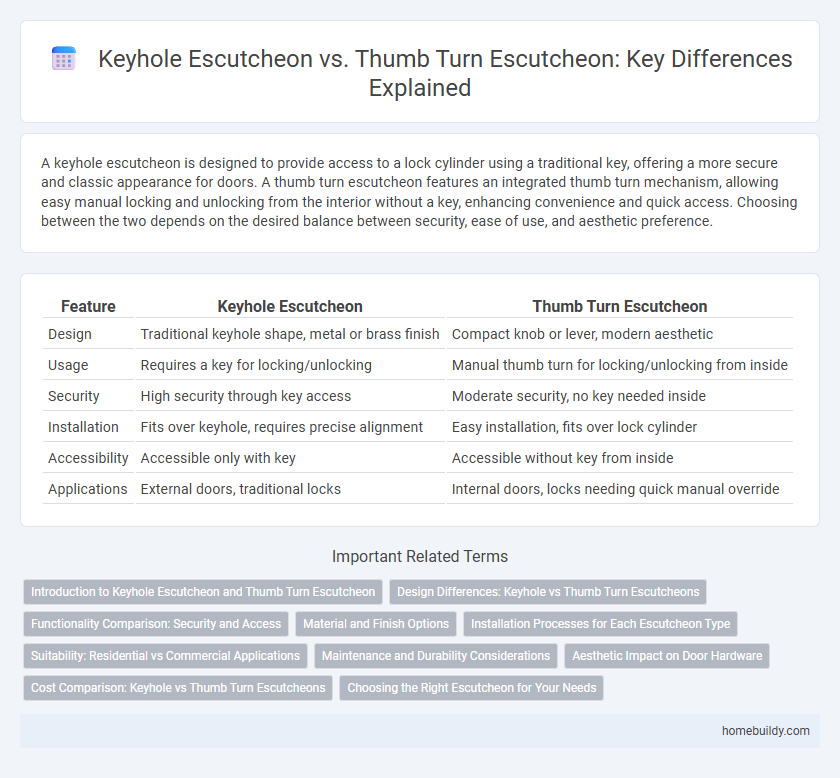A keyhole escutcheon is designed to provide access to a lock cylinder using a traditional key, offering a more secure and classic appearance for doors. A thumb turn escutcheon features an integrated thumb turn mechanism, allowing easy manual locking and unlocking from the interior without a key, enhancing convenience and quick access. Choosing between the two depends on the desired balance between security, ease of use, and aesthetic preference.
Table of Comparison
| Feature | Keyhole Escutcheon | Thumb Turn Escutcheon |
|---|---|---|
| Design | Traditional keyhole shape, metal or brass finish | Compact knob or lever, modern aesthetic |
| Usage | Requires a key for locking/unlocking | Manual thumb turn for locking/unlocking from inside |
| Security | High security through key access | Moderate security, no key needed inside |
| Installation | Fits over keyhole, requires precise alignment | Easy installation, fits over lock cylinder |
| Accessibility | Accessible only with key | Accessible without key from inside |
| Applications | External doors, traditional locks | Internal doors, locks needing quick manual override |
Introduction to Keyhole Escutcheon and Thumb Turn Escutcheon
Keyhole escutcheons are designed to provide a neat, decorative cover around traditional keyholes, enhancing door aesthetics while allowing easy access for keys. Thumb turn escutcheons feature a built-in thumb turn mechanism for quick and convenient locking or unlocking from the interior, eliminating the need for a key. Both options serve distinct security and usability functions, making them essential choices in door hardware based on access control requirements.
Design Differences: Keyhole vs Thumb Turn Escutcheons
Keyhole escutcheons feature a narrow, vertical slot designed to accommodate traditional keys, emphasizing a classic and discreet aesthetic often used in vintage or antique doors. Thumb turn escutcheons incorporate a small, rotatable knob that allows for easy locking and unlocking from the inside, prioritizing convenience and quick access. The design differences reflect distinct functional purposes: keyhole escutcheons are focused on security through key entry, whereas thumb turn escutcheons optimize user-friendly operation without a key.
Functionality Comparison: Security and Access
Keyhole escutcheons provide direct access for traditional keys, offering precise alignment for secure lock engagement but may expose keyholes to tampering or debris. Thumb turn escutcheons enable quick and convenient interior locking without the need for keys, enhancing ease of use during emergencies but potentially reducing security against unauthorized access. Security effectiveness depends on the specific lock mechanism and installation context, making the choice critical for balancing accessibility and protection.
Material and Finish Options
Keyhole escutcheons commonly feature durable materials such as brass, stainless steel, and zinc alloys, offering finishes like polished brass, satin nickel, and antique bronze to match traditional and modern door designs. Thumb turn escutcheons often utilize similar materials but may emphasize ergonomic finishes such as matte black and brushed chrome for enhanced grip and style. Both escutcheon types prioritize corrosion resistance and aesthetic versatility through varied material compositions and finish techniques tailored to security hardware.
Installation Processes for Each Escutcheon Type
Keyhole escutcheons require precise alignment with the lock cylinder, often necessitating drilling and mortising for secure attachment, which can be more time-consuming and complex. Thumb turn escutcheons typically involve simpler installation, relying on surface-mounted screws and straightforward alignment with the thumb turn mechanism. Choosing between the two depends on the door design and the installer's skill, with keyhole escutcheons generally demanding more detailed preparation compared to the quicker, less invasive process of thumb turn escutcheons.
Suitability: Residential vs Commercial Applications
Keyhole escutcheons are ideal for residential applications due to their traditional design and compatibility with standard door locks, providing straightforward access and secure closure. Thumb turn escutcheons, favored in commercial settings, enable quick locking and unlocking from the inside without a key, enhancing safety during emergencies. The choice depends on access control requirements, with keyhole escutcheons supporting key-based entry and thumb turn designs prioritizing ease of use in high-traffic environments.
Maintenance and Durability Considerations
Keyhole escutcheons require regular cleaning to prevent grime buildup that can impede key insertion, while thumb turn escutcheons typically demand less frequent maintenance due to their simpler mechanism. The durability of keyhole escutcheons depends largely on the quality of the keyhole cover and materials used, with metal variants offering enhanced resistance to wear and corrosion. Thumb turn escutcheons, often constructed from robust materials like brass or stainless steel, generally provide longer-lasting performance with minimal mechanical issues over time.
Aesthetic Impact on Door Hardware
Keyhole escutcheons provide a classic and minimalist aesthetic that seamlessly integrates with traditional and vintage door hardware designs, emphasizing subtle elegance. Thumb turn escutcheons often contribute a more robust and utilitarian appearance, making them suitable for modern or industrial door styles while enhancing user accessibility. The choice between the two significantly influences the door's overall visual impact, balancing functionality with design consistency.
Cost Comparison: Keyhole vs Thumb Turn Escutcheons
Keyhole escutcheons typically cost less than thumb turn escutcheons due to simpler manufacturing processes and fewer moving parts. Thumb turn escutcheons often involve additional mechanisms for ease of locking and unlocking, increasing material costs and complexity. Budget-conscious projects frequently favor keyhole escutcheons for their affordability without compromising basic security functions.
Choosing the Right Escutcheon for Your Needs
Keyhole escutcheons provide a traditional, discreet appearance ideal for exterior doors requiring key access, while thumb turn escutcheons offer convenience with easy interior locking control without the need for a key. Selecting the right escutcheon depends on security needs and user accessibility preferences, where keyhole escutcheons are preferred for high-security entry points and thumb turn escutcheons suit rooms needing quick manual locking. Understanding the door's function and user behavior ensures the chosen escutcheon optimizes both security and ease of operation.
Keyhole escutcheon vs Thumb turn escutcheon Infographic

 homebuildy.com
homebuildy.com